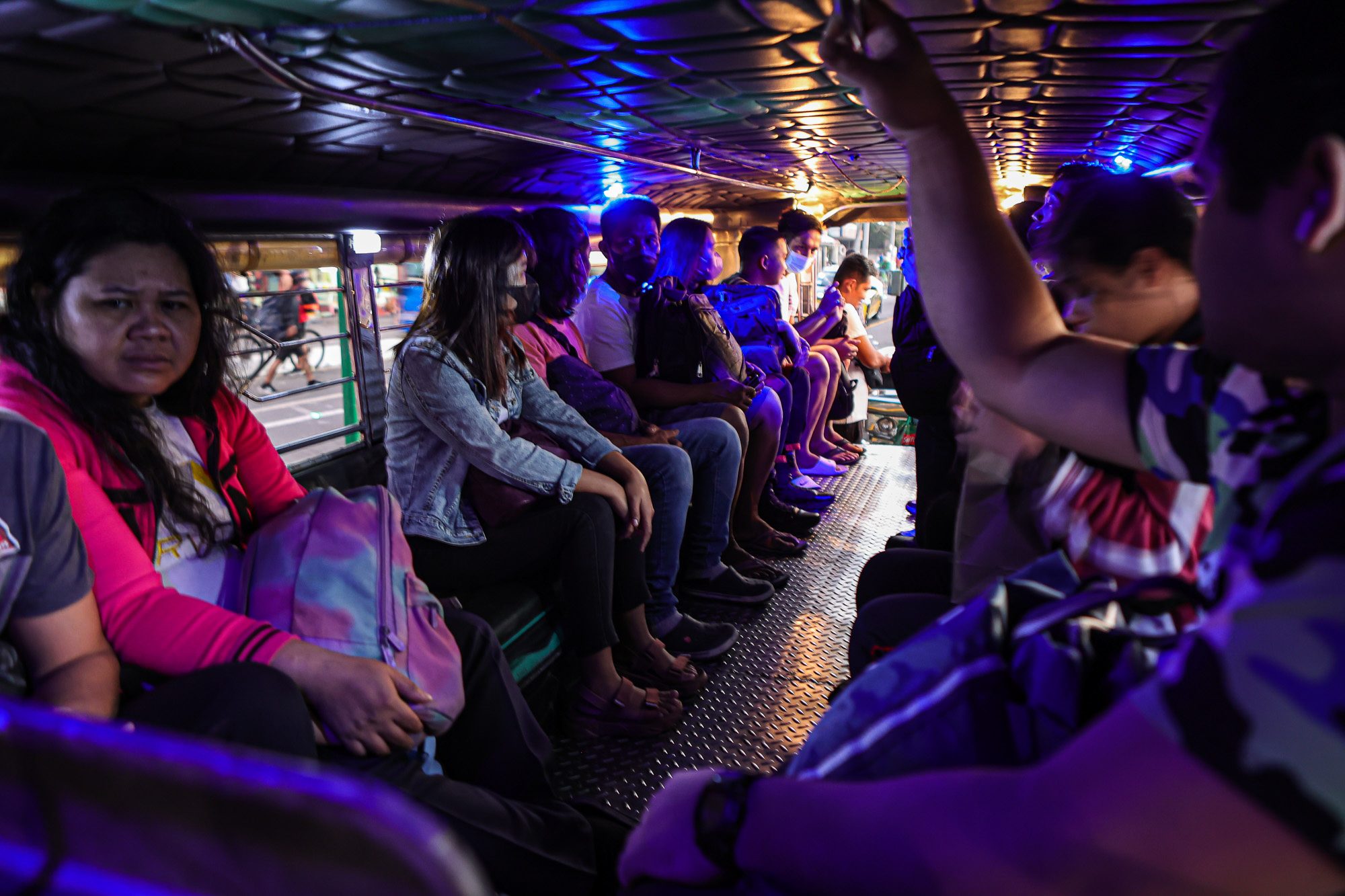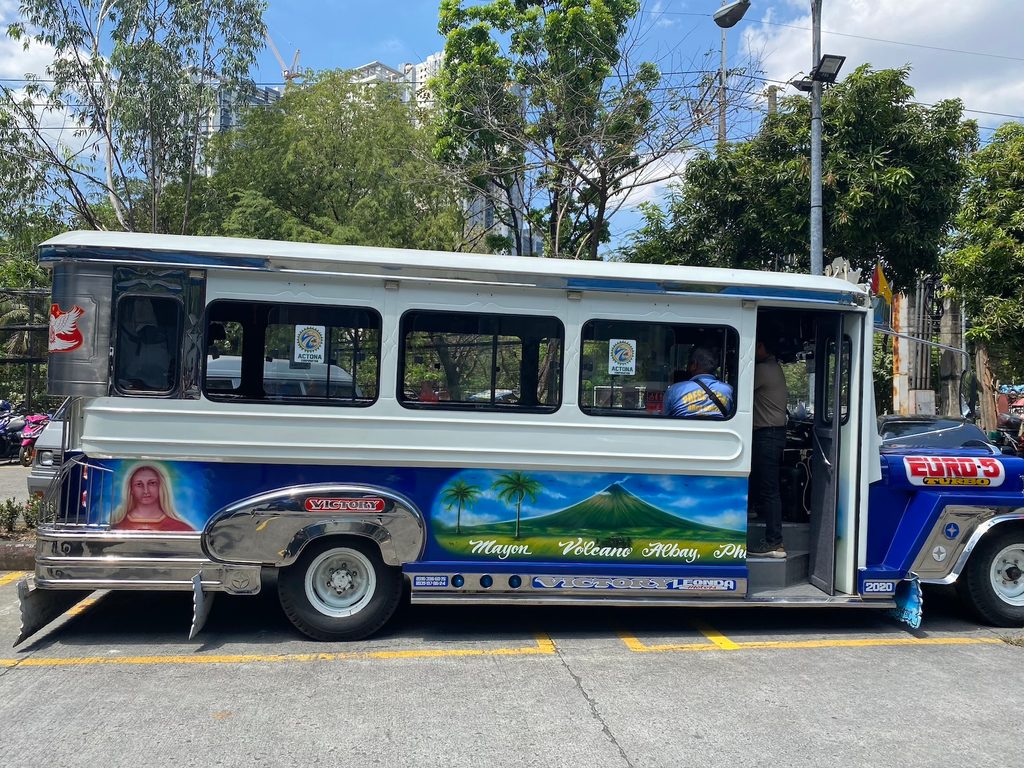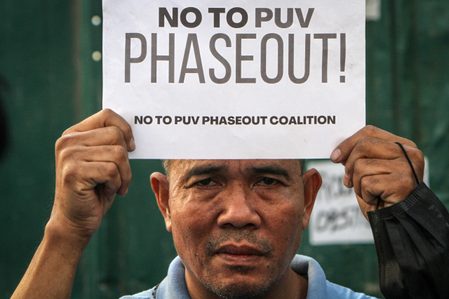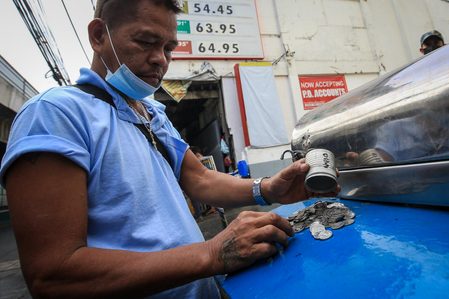SUMMARY
This is AI generated summarization, which may have errors. For context, always refer to the full article.

MANILA, Philippines – After a days-long transport strike, a Senate hearing, and a meeting of stakeholders in Malacañang, it’s clear that the public utility vehicle (PUV) modernization program is a complicated, divisive issue.
Jeepney drivers and operators began protests in late February following the release of a Land Transportation Franchising and Regulatory Board (LTFRB) memorandum circular requiring all individual jeepney operators to consolidate by June 30. Some transport groups took to the streets, spotlighting the prohibitive costs of modern jeepneys, as well as the uncertainties that come with consolidation.
The LTFRB has since extended that deadline to December 31, and the Marcos administration has also promised to use the time to conduct a comprehensive review of the modernization program.
Still, even as protesting transport groups worried about the possible phaseout of traditional jeepneys, other jeepney organizations have embraced modernization.
“Hindi naman mape-phaseout. Kasi po, ‘yung pag-form ng korporasyon o kooperatiba, ‘yan po ‘yung 15 na tao po muna ‘yung magko-consolidate. Hindi naman agad-agad na tatanggalin ‘yung mga traditional jeep,” Liberty de Luna, president and chairperson of Alliance of Concerned Transport Organization (ACTO), told Rappler in a phone interview.
(There’s no phaseout happening. Forming a corporation or cooperative of 15 operators is the first step in consolidation. It’s not like traditional jeeps will be removed immediately.)
ACTO is a part of the “Magnificent 7,” or the country’s seven largest transport groups, which generally include the following:
- Piston
- Pasang-Masda
- Alliance of Concerned Transport Organization (ACTO)
- Federation of Jeepney Operators and Drivers Association of the Philippines (FEJODAP)
- Alliance of Transport Operators’ & Drivers’ Association of the Philippines (ALTODAP)
- Liga ng Transportasyon at Operators sa Pilipinas (LTOP)
- UV Express National Alliance of the Philippines (UV Express)
With the exception of Piston, none of the Magnificent 7 joined the March 6 transport strike. Several other groups – such as the National Federation of Transport Cooperatives, Stop and Go Coalition, and Senate Employees Transport Service Cooperative – have all expressed support for the consolidation and modernization program.
Consolidation as a first step
“It is recognized that the jeepney sector is highly fragmented and individualized in terms of ownership and operation. It is responsible for the existence of single operators that compete on the streets,” read a 2022 report by the Japan International Cooperation Agency, the Japanese city planning firm ALMEC, and Oriental Consultants Global.
For this reason, the government considers consolidation as a crucial first step in the PUV modernization program. As required by the LTFRB, individual jeepney operators must consolidate into cooperatives or corporations.
Those seeking to establish a cooperative need at least 15 individuals to join and register with the Office of Transportation Cooperatives, a process that could cost more than P750,000 for the group.
Operators could also establish corporations, which are registered with the Securities and Exchange Commission. In doing so, they also have the option to apply for a franchise as a one-person corporation, the LTFRB clarified in a House committee hearing on Thursday, March 9. This means that individual operators could technically retain their franchises without joining larger organizations, but the LTFRB has yet to clarify whether any one-person corporations have been granted franchises.
Benefits of consolidation
So what benefits come with consolidation? According to the Department of Transportation (DOTr), operators in consolidated entities can pool their funds, share in their operational and management costs, and gain access to loans from banks to buy modern jeepneys.
This also means that any profits that the cooperative or corporation makes can likewise be shared among members.
“Kung may matitira, may share naman po sila doon every end of the year. Pero dapat bayaran muna ‘yung tax nila, ‘yung BIR nila, ‘yung mga pang-renew ng registration nila,” De Luna said.
(If there are profits remaining, they all get a share at the end of the year. But, first, they need to pay their tax, their obligations to the Bureau of Internal Revenue, and the renewal of their registration.)
For De Luna and the other members of ACTO, consolidation also brings promises of better routes, steady salaries for drivers, health insurance, and social security benefits – and, of course, safer, cleaner modern jeepneys.
Route rationalization
After consolidating, the plan is for jeepneys to ply along rationalized routes. This comes in the form of local public transport route plans (LPTRP) prepared by local government units (LGUs). These will detail route networks, modes, and the required number of units per mode to deliver public land transport services.
“Kino-consolidate po kasi ‘yan para doon sa rationalization, kung ilan ‘yung p‘wedeng ilagay doon sa bawat area,” De Luna said. (They are being consolidated for rationalization, which is how they determine how many will be allowed to ply in each area.)
Originally, only a single cooperative or corporation was allowed to operate within each route, to allow operators to more efficiently deploy jeepneys and avoid over-competition. But this can lead to larger routes being dominated by a single cooperative or corporation with hundreds of members.
“Pinapag-join kami para maging one na. Ang problema lang naman kasi, s‘yempre ‘yung mga association, may 200 silang operators. E ‘bat naman sila sasali doon sa mga korporasyon na kokonti lang ‘yung tao? Sinagot naman po tayo ng ating LTFRB, ng ating Secretary Jaime, na sa isang ruta po, tatlo na po ang p‘wedeng bumiyahe,” de Luna said.
(We’re being asked to join and become one. The problem is that, of course, some associations have around 200 operators. Why would you then join a corporation that has only a few members? The LTFRB and Transport Secretary Jaime Bautista has already addressed this issue, saying that up to three consolidated entities are allowed to ply each route.)
During a press conference held at the height of the transportation strike, the LTFRB announced they were considering allowing up to three cooperatives or corporations to operate along larger routes.
However, senators have also cast doubt on the readiness and capability of LGUs to prepare their route plans. During the Senate hearing, Senator Joel Villanueva pointed out that only 8.8% of route plans were approved, or 139 LPTRPs out of an expected 1,575 across all cities and municipalities.
The slow creation and approval of LPTRPs could also affect the attempt of transport cooperatives and corporations to modernize. They can only avail themselves of loans for modern jeepneys once they have an LPTRP for their route, a representative from the Development Bank of the Philippines (DBP) said during the hearing.
Fixed salary, social security benefits
The modernization program would also allow drivers to finally move past the controversial boundary system, according to De Luna.
Under the current system, jeepneys are owned by individual operators. The operators then charge a “boundary,” or daily quota, that jeepney drivers must meet. Whatever drivers earn above this quota belongs to them as their income. This is often the reason some drivers drive their jeepneys recklessly along routes in a race to pick up as many passengers as they can.
“At least, hindi na sila maghahabol-habol pa ng kanilang biyahe. At least, ‘yung mga drivers natin, may P650 a day,” De Luna said. “Hindi ka na hahabol pa or magkukumahog na kailangan ‘yung oras mo, i-drive mo talaga ‘yung sasakyan. At least ito, maaalagaan na po sila, at may sarili silang suweldo na hindi na sila maghahabol ng boundary.”
(At least, they won’t be rushing their journeys. At least, our drivers are assured an income of P650 a day. They don’t need to drive for long hours. At least in that set-up, they’ll be taken care of, they’ll have a salary, and they don’t need to chase after their quotas.)
A salary of P650 means that drivers at least earn above the minimum wage. Because drivers also become formally employed under cooperatives and corporations, they will receive mandatory government benefits from Social Security System (SSS), Philippine Health Insurance Corporation (PhilHealth), and the Home Development Mutual Fund (Pag-IBIG).
“’Yung mga drivers natin, may mga healthcare na naka-ready na po. Kasi karamihan sa mga drivers, walang SSS, walang PhilHealth. Pero, ngayon, mandatory na po na lalagyan po sila,” De Luna said.
(Our drivers will have healthcare ready for them. Before, most drivers weren’t members of SSS or PhilHealth. But, now, it’ll be mandatory [for operators] to pay the drivers’ membership dues.)
Modern jeepneys
At the heart of the PUV modernization debate is the modern jeepney. The DOTr stated that new jeepneys come with a host of features, which include:
- Curbside-facing doors
- Navigational GPS
- Free Wi-Fi
- CCTV cameras
- Automatic fare collection systems
- Speed limiters and dashboard cameras
- PWD accessibility ramps
Modern jeepneys must also comply with the Philippine National Standard for PUVs, which is set by the Department of Trade and Industry (DTI). These outline specific requirements for the size and safety features of different PUV classes. They also require modern jeepneys to have either Euro-4-compliant, electronic, or hybrid engines, or better.
While modern jeepneys are meant to overhaul the traditional, decades-old icons of Philippine roads, the government has also made some effort to preserve its original aesthetic. For instance, a locally manufactured jeepney model displayed in the LTFRB central office shows how a modern jeepney that complies with the Philippine National Standard can still resemble the look of traditional jeepneys.

Commuters and transport groups alike have appealed to the government to preserve the image of traditional jeepneys even as modernization seeks to improve their other technical aspects. (READ: [OPINION] The jeepney phaseout as a cultural issue)
“Dito tayo nakilala sa Pilipinas na ‘yung jeep eh talagang tayo lang ang meron. Tapos biglang aalisin, ‘di ba?” said Maria Perez, a commuter in a Guadalupe jeepney terminal. (After all, this is how we became known. The jeepney is unique to the Philippines, and now they’re going to take it away?)
“Ang gusto ko sa PUJ modernization, gusto ko po kasi, ‘yung icon po ng ating traditional jeeps ay ma-preserve. ‘Yun po ang aking hinihiling sa ating gobyerno na sana po ay mapabigyan po kami,” De Luna said as well.
(What I want in this PUJ modernization is for the icon of traditional jeepneys to be preserved. That’s my request from our government, which I hope they can oblige.)
Of course, modernization comes with its price. In this case, traditional jeepneys, which go for around P150,000 to P250,000, will now be replaced by modern models that can cost over P2 million.
For De Luna, the government has set aside a large enough equity subsidy to make the upgrade, which can range from P210,000 for Class 1 jeepneys to P360,000 for Class 2, Class 3, and Class 4 jeepneys, and Class 3 and Class 4 UV express vehicles.
“Kapag uutang na po tayo, ang ating gobyerno naman po ay may subsidy para pang-down doon sa bangko,” de Luna said. (When we’re taking out loans, the government will give a subsidy for our downpayment with the banks.)
Dealing with high prices
Despite the benefits that come with modernization, De Luna agreed that the program still comes with some issues, as recognized by other protesting transport groups. The most pressing of these is the high cost of modern jeepneys.
“‘Yun nga po ang problema namin. Kaya nga, super mahal – P2.4, P2.8 [million]. Parang hindi po namin kayang bayaran,” De Luna said. “Super mahal po talaga. Grabe. Di po namin kakayanin. Malulubog po kami sa utang.”
(That’s our problem, it’s so expensive – P2.4, P2.8 million. We can’t afford to pay for that. It’s just too expensive. We’ll sink into debt.)
While the subsidy would allow operators to buy vehicles without having to put up their own equity, it would still leave them with millions of debt to pay off.
Both the DBP and Landbank of the Philippines – the two state banks extending loans for modernization – confirmed that jeepney operators and drivers would struggle to pay off loans, given the steep price of modern units.
“Based on our initial study when we were involved in the conceptualization of this project, we found that operations of transport entities are to be viable if the cost is within P1.6 million to P1.8 million per unit,” said Landbank assistant vice president Genoroso David during the House committee hearing.
He added that with units now costing from P2.3 to P2.8 million, “the viability is now questionable.”
DBP vice president Rustico Cruz also said during the House hearing that, given the current prices of modern jeepneys, operators would have to pay a monthly amortization of P38,000 to P40,000 for seven years.
Government transport agencies are currently pushing for operators to consider cheaper, locally manufactured jeepneys that also fulfill the Philippine National Standards. The prototype displayed at the LTFRB central office, for instance, only costs about P1.3 million.
Should modern jeepneys eventually drop to this price range, De Luna confirmed that most operators could already afford to modernize.
Monopoly fears
De Luna said that another lingering issue of the modernization program was the danger of monopolies cornering routes, which she relayed is already happening in some areas.
“Mahirap po kasi. ‘Yun kasi nangyayari nga po ngayon talaga, eh s‘yempre, ‘yung mga unang korporasyon o kooperatiba, humihingi po ng membership. Napakamahal,” De Luna said.
(That’s what’s difficult. Right now, the corporations and cooperatives that formed earlier are asking for membership fees. It’s really expensive.)
According to De Luna, some cooperatives that consolidated early on are now charging membership fees, which can reach as high as P200,000.
“’Yun ang inaayawan namin. Kung mga association namin, sila na rin po mismo ‘yung magkokorporasyon, sila na rin ang chairman, eh ‘di hindi sila mahihingan ng membership na ganun kalaki. Saan naman kukuha ng P100,000 o P150,000? Kaya nga may subsidy from the government eh, para doon sa pang-down sa bangko. Bakit naman kung mag-i-in naman sila, magjo-join lang, ay napakahirap po noon,” De Luna said.
(That’s what we’re against. If associations will be the one to set up their own corporations, they’ll also be the chairman, so they wouldn’t ask for membership fees that large. Where are operators supposed to get P100,000 or P150,000? That’s precisely why the government is giving subsidies, so that they’d have something to use for down payment with the banks. Why would they make it so difficult just to join?)
Meanwhile, other transport groups, such as PISTON, also raised the possibility of big businesses taking over routes following the consolidation process.
“Sa oras na ‘di ka makabayad sa napakamahal na halaga ng modernization, wala ka nang babalikan dahil pinilit kang isuko ang prangkisa mo. Ano’ng mangyayari sa consolidated franchise ng coop niyo? Ibi-bid ng LTFRB sa mga malalaking korporasyon na may kakayahang magbayad ng mga imported minibus na isinusubo ng gobyerno,” said PISTON national president Mody Floranda in a press release.
(When the time comes that cooperatives can’t pay for the high costs of modernization, operators won’t have anything to come back to anymore since they’ve already been forced to give up their individual franchises. What will happen to the consolidated franchise of your cooperative? The LTFRB will bid it to large corporations that have the financial means to pay for imported minibuses that the government is forcing on us.) – Rappler.com
Add a comment
How does this make you feel?







![[Under 3 Minutes] When will we see modern jeepneys on the road?](https://www.rappler.com/tachyon/2024/04/francisco-motors-modern-jeepney-prototype-1.jpg?resize=257%2C257&crop=590px%2C0px%2C1012px%2C1012px)
There are no comments yet. Add your comment to start the conversation.